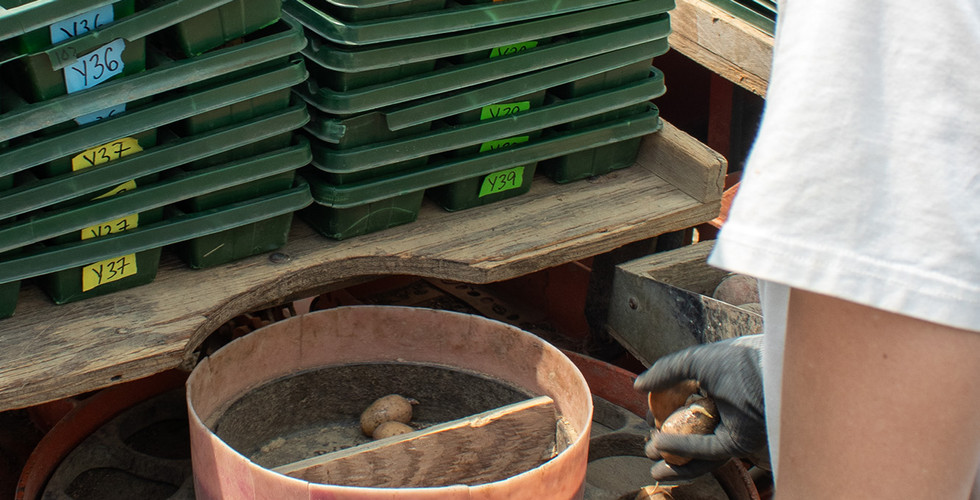Selecting for Success: Thousands of Clones Go into the Ground
- piaspychalla
- Dec 19, 2024
- 2 min read

In every potato breeding program, thousands of different clones are grown and evaluated each year. The Cornell potato breeding program uses a two-row planter to plant about 8-10 acres of Mount Pleasant research fields each year. The first planting stage in the breeding pipeline is known as the “fourhills” by Cornell breeding program staff. Its name comes from the fact that four minitubers are planted for each unique clone. As the first stage of selection in the pipeline, this generation has the largest number of clones, about 16,000 in recent years.
Planting this quantity of tubers requires careful organization. Fifteen-cell trays are labeled with a cross ID code (e.g., Y1, Y2, Y3, Y4, etc.) and then four minitubers per clone from that cross are placed into each cell. The trays are then organized on the planter according to the planting plan previously laid out by potato breeder Walter De Jong and research support specialist Matt Falise.
Before setting out, the planter is stocked with fertilizer and the tractor spray tank is filled with pesticides. These additives promote growth and prevent attacks from various potato insects and pathogens. Once everything is prepared, planting can start. The tractor drives slowly through the field as the crew members handle the tubers. The main feature of the planter is a rotating wheel that serves to properly space tubers in the row.The wheel slowly turns clockwise as tubers are manually placed into each slot. Once the tubers reach the 12 o’clock position on the wheel, they drop down into a furrow previously plowed by disks further up the planter. Simultaneously, fertilizer is continuously dropped into the furrow and pesticide is sprayed on top of planted tubers. Lastly, disks located at the back of the planter cover the tubers to create a small ridge.
Given the large number of clones, clear separation is important to differentiate one plot from the next at harvest. This is done with marker potatoes. These potatoes can have white, red, or purple skin. Which color is used depends on the skin color of the cross being evaluated, e.g., a few hills of red clones are typically used to separate plots of white clones. The shift in tuber color at harvest serves as a reliable indicator of a clone change. In addition, a stake with the cross ID code is placed at the start of each new family in the field, to separate that cross from all other crosses planted that season.
Commonly grown cultivars like Atlantic and Snowden are planted as well to establish a benchmark for performance. These cultivars are referred to as “checks.” Check varieties are important since each growing season has different environmental conditions and what matters is performance relative to checks rather than absolute performance per se.
Planting in the Cornell Breeding Program typically starts at the beginning of May. According to Matt Falise, the program has never planted into the month of June. But they have sometimes planted on what humorously gets called “May 36th.”
This blog was originally posted to PAPAS website at https://potatonematodes.org/
Supported by the USDA National Institute of Food and Agriculture award number 2022-51181-38450









Comments